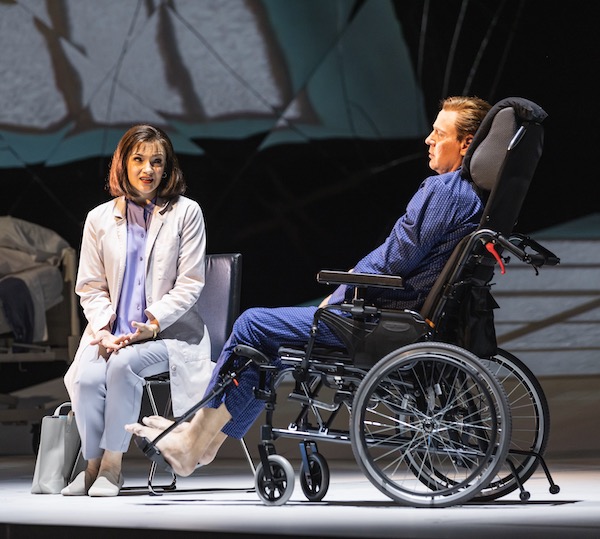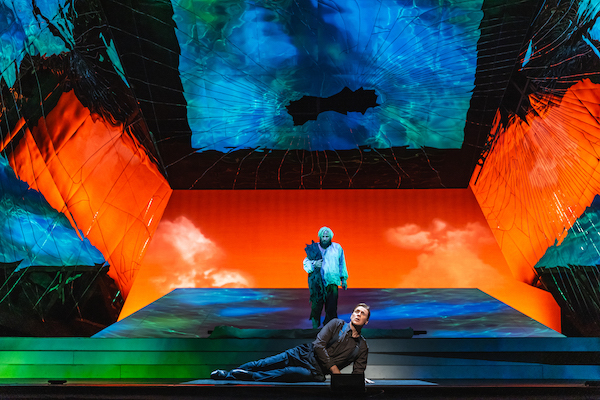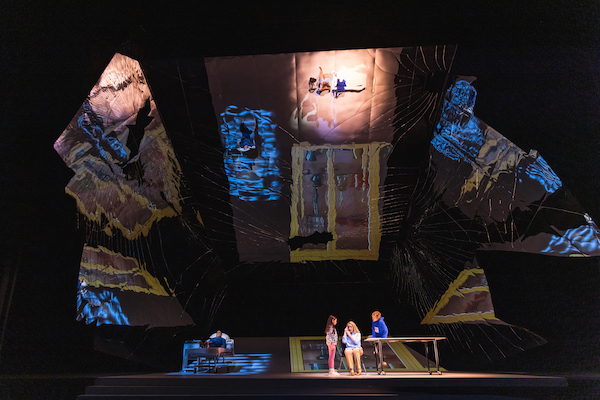Tragedy turns to triumph in compelling “Diving Bell” premiere at Dallas Opera

Composer Joby Talbot has joined forces again with librettist Gene Scheer for The Diving Bell and the Butterfly, presented by Dallas Opera in its world premiere Friday night at the Winspear Opera House. The same team (also with director Leonard Foglia) anchored the company’s premiere of Everest in 2015.
The current opera tells the true story of French journalist Jean-Dominique Bauby who suffered a devastating stroke and a resultant “locked-in syndrome.” The condition severely limited his physical abilities—he could only move eyes and blink—although his mind was fully functional and conscious.
The opera’s title reflects the two extreme states that Bauby experienced: the sensation of being trapped as if alone at the bottom of the ocean, and the freedoms of flight that characterize his fantasies and memories.(Bauby’s 1997 memoir was adapted by Julian Schnabel and Ronald Harwood into an award-winning 2007 film.) In addition to the published memoir, Scheer built on his extended interviews with Bauby’s widow and two children.
Talbot harnesses music across a wide stylistic spectrum for expressive purposes. Mild to harsh dissonances illustrate Bauby’s frustration at the inability to communicate, and dark memories of the onset of the stroke. Happier memories or fantasies incorporate smoother harmonies. For Bauby’s warm reminiscences of cooking for the family or managing the publication of his magazine, the music takes on a jazzy idiom, with walking pizzicato bass and a light, swinging ride cymbal. The most attractive music accompanied nostalgic scenes of family, childhood, and some memories from the Count of Monte Cristo.
Talbot is a melodic writer, able to capture the feelings and ideas of each character. He contours his melodies to fit the characters’ personalities—most evident in the counterpoint of small ensembles—and large groups of cast gather to sing finales at the ends of each act. Talbot handles duos and trios deftly, but most potent was the quintet singing an ostinato of “over and over … again.”
Bauby was portrayed by Lucas Meachem, the Grammy-winning baritone whose Dallas Opera role successes in the last six years include Rossini’s Figaro, Sharpless, and, earlier this year, Guglielmo in Così fan tutte. Meachem’s voice was self-assured and exuberant, spending most of his solo singing in his upper octave.
Bauby is initially isolated and horrified as he begins to realize that nobody can hear him—especially painful for a professional writer, a man of words. He rises from his bed whenever he experiences vivid fantasies or memories, as in his opening dialog with a mysterious character surrounded by fractured images of stones in a wall. We learn later that his conversation partner is the Abbé Faria, the Italian priest imprisoned in Dumas’s Count of Monte Cristo, which Bauby had planned to rewrite from a heroine’s perspective. Faria was sung by Richard Croft in an elegant tenor. The harmonious duo for Meachem and Croft found Meachem lower in his range.

Act 2 began on a light note, at the beach with his wife Sylvie and their children, and following Bauby’s breakthrough willingness to spell with Sandrine. A clever comic touch was Sylvie’s reaction to the entrance of Claude (soprano Deanna Breiwick), a transcriber sent from Bauby’s publisher but whom Sylvie mistakes for her husband’s mistress. Explaining that Sandrine does not have the time to transcribe Bauby’s book all day, Breiwick and Andriana Chuchman begin a soaring duo that soon adds Sasha Cooke to form the crystalline trio “One more day,” based on their admiration for Bauby’s writing.
Another Grammy winner and cast member from the 2015 Everest production was Cooke, who sang Sylvie with a refined mezzo-soprano. Enhancing the opera’s realistic approach, her acting was subdued, her fears and confusion free of melodrama.
Soprano Chuchman, a fine actress with a lithe, clear tone, portrayed Sandrine, the speech therapist who formulated a system by which Bauby could blink to communicate—first in simple “yes” and “no” answers but eventually alphabetically, enabling him to compose his memoir. His yes/no blink responses were reinforced visually by “blinking” the entire projections. The unsympathetic physician, played comically by tenor Andrew Bidlack, was sung with apt snark.
Elaine J. McCarthy’s scenic design included a broad central-staired platform surrounded by dramatic angled screens for projections. The main image was thrown onto a central ramp, then reflected in huge panels of jagged mirrors on either side and suspended well above. Rich blues accented with subtle greens, gold, and occasional reds brought relief to the sterile off-white scenes in the hospital.
Russell H. Champa’s lighting designs were mostly understated and well coordinated with McCarthy’s projections. Lighting and projections reached a dramatic climax for the final scarlet sunrise. Director Leonard Foglia made good use of the spaces on stage and the variety of angles afforded by the mirror panels.
Conductor Emmanuel Villaume was sensitive to the score, crafting the lush colors of Talbot’s compelling orchestration. The orchestral writing is supportive, never battling with the singers. Instrumental lines double the vocal soloists in selected passages. For the final epiphany, the sublime orchestral backdrop suggested neo-Wagnerian sonorities.
Music, images, and lighting combined for wonderful transitions between Bauby’s inner and outer worlds. These and the mechanical sounds of hospital instruments and telephones were especially effective since Bauby was often unable to distinguish dreams from reality, with each frequently interrupting the other.

The Diving Bell and the Butterfly runs through November 11. The final performance will be livestreamed. dallasopera.org
Stuart Cheney’s articles and reviews have appeared in Early Music, Grove Music Online, MLA Notes, Opera News, and A Performer’s Guide to Seventeenth-Century Music. Before joining Texas Christian University, he taught music history and directed early music ensembles at Southern Methodist University, Goucher College, the University of Maryland, and Vanderbilt University. Stuart also plays viola da gamba and electric bass.


